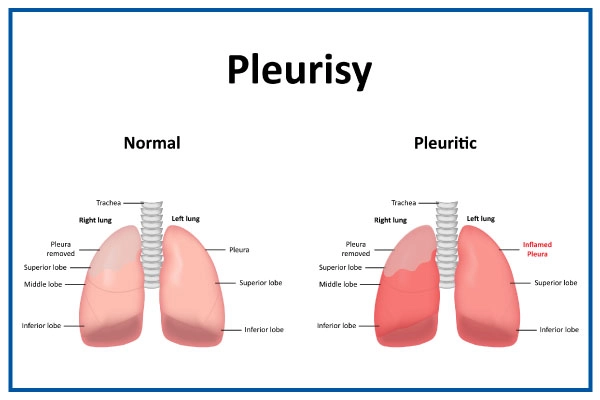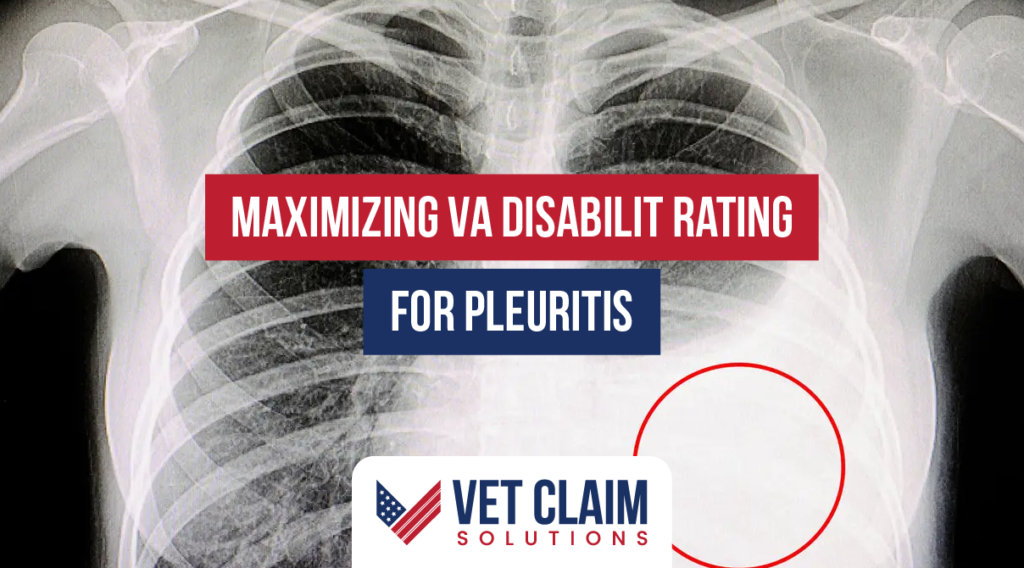Navigating the world of VA Disability Ratings for Pleuritis can feel like traversing a labyrinth without a map. But here, we aim to light your way. You’ll discover how pleuritis is recognized within the VA system and why linking it directly to your military service matters more than you might think.
From understanding secondary conditions linked to pleuritis due to burn pit exposure, to diving into the specifics of diagnostic criteria and compensation exams, this guide doesn’t miss a beat. We’ll also touch on how this condition impacts lung function and what that means for your health.
Lastly, we peel back the curtain on navigating VA benefits and appeals if you’re initially denied, plus recent legislative changes boosting veterans’ rights. Armed with knowledge from our comprehensive exploration, taking control of your claim starts now.
Understanding VA Disability Ratings for Pleuritis

Pleuritis, a condition that inflames the lining of the lungs and chest, can cause sharp pain with every breath. Navigating life after service, numerous veterans encounter the harsh truth of battling pleuritis, a condition often triggered by their exposure to hazardous environments while serving.
Veterans seeking disability benefits for pleuritis need to establish a direct service connection. This means showing that their pleuritis is linked to their military service. But it doesn’t stop there; if pleuritis has led to more severe health issues or was caused by another service-connected condition, this could affect your VA disability rating.
What is Pleuritis?

This respiratory condition often feels like being stabbed in the side with each deep breath you take—a sensation no one should have to live with daily. Beyond chest pain, common symptoms include coughing and shortness of breath.
To get VA benefits for pleuritis, proving it’s related directly or indirectly (secondary) to your time in uniform is crucial. Direct links might come from exposure risks like burn pits or other known pulmonary threats faced while serving.
Establishing Direct Service Connection
Achieving a direct service connection involves gathering evidence: medical records confirming your diagnosis and documentation tying your condition back to military duty are essential steps here. Sometimes though, establishing this link needs an extra push—like when conditions presumed connected due legal changes come into play; think Agent Orange or burn pit exposure legislation updates affecting presumptive conditions lists.
Service Connection Pathways for Pleuritis
Veterans facing pleuritis have specific paths to link their condition directly or secondarily to military service. Understanding these connections is crucial in securing VA benefits.
Secondary Conditions Linked to Pleuritis
Pleuritis, often a painful inflammation of the pleura surrounding the lungs, can be both a standalone issue and a signpost pointing towards other serious conditions. Veterans who were exposed to environmental hazards like burn pits or Agent Orange during service may find themselves battling not just pleuritis but also secondary respiratory cancers, restrictive lung disease, and more due to that exposure. Grasping this link is crucial for securing an accurate disability rating from the VA.

The Honoring Our PACT Act has been a game-changer here. It recognizes conditions like pleuritis as presumptive when linked with certain exposures, making it easier for veterans to claim benefits without jumping through endless hoops of medical proof.
Military service offers unique challenges; some leave physical marks while others creep up silently like stealthy shadows long after duty ends. Burn pit exposure stands out as particularly insidious because its effects—respiratory diseases among them—are slow yet devastatingly pervasive over time.
To successfully navigate these waters and secure deserved compensation requires an adept understanding of how different factors interlink within VA’s legal framework—a task our veterans should not have to face alone.
Diagnostic Criteria and Compensation Exams
Veterans seeking disability compensation for pleuritis often face a critical hurdle: the Compensation and Pension Exam (C&P). This exam is where medical evidence meets legal criteria to establish eligibility. Understanding what this entails can make all the difference.
Compensation and Pension Exam
The C&P exam plays a pivotal role in evaluating your current diagnosis against established diagnostic codes for various medical conditions, including pleuritis. It’s not just about confirming you have pleuritis; it’s about demonstrating how it affects you daily. As part of their assessment, veterans might be subjected to breathing capacity exams or thoracic radiographs, essential measures for gauging lung dysfunction.
To navigate this process successfully, familiarity with the VA’s language and standards is key. The Veterans Law Guide offers insights into understanding these terms better.
Current Diagnosis vs Diagnostic Code
Making sense of your condition relative to VA standards means aligning your health status with specific diagnostic codes—a task easier said than done without guidance. Here, detailed records from healthcare providers become invaluable, offering concrete data on lung function through pulmonary function tests or documenting symptoms like chest pain which are common but significant indicators of severity.
A successful claim hinges on illustrating not just presence but impact—how pleuritis limits life post-service. Dive into our collection for in-depth guidance on converting healthcare records into persuasive claims.
Impact on Respiratory Function and Health
Pleurisy could severely compromise your pulmonary function, transforming each inhalation into an arduous endeavor. It’s not just about dealing with chest pain; this condition can lead to complications like respiratory failure if it’s not managed properly.
Assessing Lung Capacity with Pulmonary Function Tests
To grasp the extent of pleuritis’s effect on your respiratory health, physicians frequently utilize lung function assessments. These include spirometry and diffusion capacity tests that measure how well you’re pulling in oxygen and getting rid of carbon dioxide. Think of these tests as your lungs’ personal fitness check-up, ensuring they’re performing at their peak—or identifying when they’re falling short.
Spirometry is particularly telling because it measures the amount of air you can inhale and exhale, plus how quickly you can do so. A drop in these numbers could be a red flag for pleuritis or other underlying conditions causing trouble in paradise—your lungs.
The role these evaluations play cannot be overstated—they are crucial for diagnosing issues like restrictive lung disease or even spotting early signs of respiratory cancers linked to service-related exposures such as burn pits or Agent Orange. And yes, things like deep breathing exercises might sound simple but become Herculean tasks when facing severe restrictions due to pleuritis.
If you suspect your breathing troubles might have roots in military service, especially if there was exposure to known hazards, exploring VA disability benefits is worth considering—as it may open doors to compensation and treatment options tailored specifically for veterans grappling with respiratory conditions post-service.
Navigating VA Benefits and Appeals Process
Filing for VA disability benefits can feel like trekking through a maze blindfolded. But when it comes to pleuritis, knowing the right steps can turn that maze into a straight line.
To start, you’ll need to file a disability claim with the VA. If your condition is directly linked to your service—like if those burn pits left you wheezing—you might be eligible for compensation. This direct service connection is crucial because it’s how the VA determines if your health woes stem from your time in uniform.
So, what’s the plan if they give you a thumbs down? First off, don’t panic. You’re not at a dead end; there’s an appeals process. It’s here where having evidence becomes as valuable as gold during the Gold Rush era. Gather medical records, buddy statements, or anything else that proves pleuritis has got you by the lungs because of military service.
Sometimes though, pleuritis tags along with other conditions like respiratory cancers or restrictive lung disease due to environmental exposures such as Agent Orange or pit exposure during deployment—these are known as secondary conditions. The key here is establishing this link which could bolster your claim.
If all these sound daunting and complex—it can be—but help exists. Organizations dedicated to veterans law specialize in navigating these choppy waters alongside you every step of the way.
Legislation Impacting Veterans with Pleuritis
Veterans dealing with pleuritis have a beacon of hope thanks to recent legislative changes. The enactment of the Honoring Our PACT Act marks a pivotal transformation in the quest for disability benefits, reshaping support frameworks.

The Act’s expansion to include ailments such as pleuritis among its presumptive conditions due to specific exposures marks a pivotal moment in legislative evolution. For veterans who breathed in harmful substances from burn pits or were exposed to Agent Orange, this is big news. Now, proving a direct service connection might be less cumbersome.
But what does this mean on paper? Simply put, if you served and got exposed in specific ways that are now recognized under the Honoring Our PACT Act, your path to securing benefits just got clearer. This doesn’t only cover pleuritis but extends to other respiratory conditions and even some types of cancer believed tied to military service environments.
The importance of understanding these updates cannot be overstated for anyone aiming at maximizing their VA disability rating or embarking on an appeals process after an initial denial. With over 3 million veterans potentially affected by exposure issues alone, knowledge about such legislative evolutions isn’t just power—it’s empowerment towards better health management and deserved recognition for sacrifices made.
Conclusion
Navigating VA Disability Ratings for Pleuritis just got simpler. We walked through its recognition, the importance of linking it to your service, and how secondary conditions can play a role.
Understanding diagnostic tests and compensation exams is crucial. These instruments serve as your evidence in substantiating your claim. Remember, lung function matters; tests like spirometry reveal the impact on your health.
Tackling the benefits and appeals process might seem daunting at first glance. Yet, armed with this guide, you’re better prepared than ever before.
Legislative changes like the Honoring Our PACT Act are game-changers for veterans with pleuritis. Now, they’ve flung wide the gates for pursuing compensation due to burn pit exposure, a move that’s both straightforward and revolutionary.
In sum: knowledge is power when it comes to securing what you’re owed under VA disability ratings for pleuritis. Let’s use it wisely.


